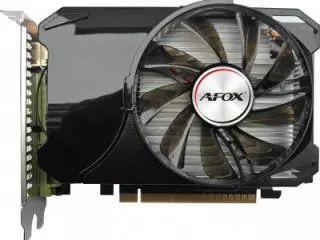GeForce 820A vs GeForce GT 740
If you are going to buy a new graphics card and are choosing between GeForce 820A and GeForce GT 740, there are a couple of things to consider. Cards with more VRAM in general perform better and allow you to play on higher graphics settings. Size also makes a difference. A model with a large heatsink can occupy up to three expansion slots on a motherboard. Be sure you have enough room in your PC case. When comparing GPUs with different architectures, more processing cores and even higher TFLOPS will not always translate to better performance. To help you decide which GPU you need, we have measured frame rates in a number of popular games. For more on how the GeForce 820A stacks up against GeForce GT 740, check out specs charts below.
GeForce 820A
Main Specs
GeForce 820A
GeForce GT 740
Power consumption (TDP)
15 Watt
64 Watt
Interface
PCIe 2.0 x16
PCIe 3.0 x16
Supplementary power connectors
1x 6-pin
Memory type
DDR3
GDDR5
Maximum RAM amount
1 GB
1 GB
Display Connectors
No outputs
2x DVI, 1x mini-HDMI
Check Price
GeForce GT 740 has 326% more power consumption, than GeForce 820A.
GeForce 820A is connected by PCIe 2.0 x16, and GeForce GT 740 uses PCIe 3.0 x16 interface.
GeForce 820A and GeForce GT 740 have maximum RAM of 1 GB.
Both cards are used in Desktops.
GeForce 820A is build with Fermi 2.0 architecture, and GeForce GT 740 - with Kepler.
Core clock speed of GeForce GT 740 is 218 MHz higher, than GeForce 820A.
GeForce 820A and GeForce GT 740 are manufactured by 28 nm process technology.
Memory clock speed of GeForce GT 740 is 3212 MHz higher, than GeForce 820A.
Game benchmarks
Assassin's Creed Odyssey
Battlefield 5
Call of Duty: Warzone
Counter-Strike: Global Offensive
Cyberpunk 2077
Dota 2
Far Cry 5
Fortnite
Forza Horizon 4
Grand Theft Auto V
Metro Exodus
Minecraft
PLAYERUNKNOWN'S BATTLEGROUNDS
Red Dead Redemption 2
The Witcher 3: Wild Hunt
World of Tanks
high / 1080p
0−1
7−8
ultra / 1080p
−
4−5
QHD / 1440p
0−1
0−1
low / 720p
1−2
16−18
medium / 1080p
0−1
8−9
The average gaming FPS of GeForce GT 740 in Assassin's Creed Odyssey is 1600% more, than GeForce 820A.
high / 1080p
−
12−14
ultra / 1080p
−
10−11
QHD / 1440p
0−1
0−1
low / 720p
0−1
24−27
medium / 1080p
−
12−14
low / 768p
50−55
45−50
high / 1080p
45−50
45−50
QHD / 1440p
0−1
0−1
The average gaming FPS of GeForce 820A in Call of Duty: Warzone is 6% more, than GeForce GT 740.
low / 768p
60−65
140−150
medium / 768p
27−30
110−120
ultra / 1080p
7−8
55−60
QHD / 1440p
−
30−33
4K / 2160p
−
27−30
high / 768p
16−18
80−85
The average gaming FPS of GeForce GT 740 in Counter-Strike: Global Offensive is 257% more, than GeForce 820A.
low / 768p
70−75
55−60
ultra / 1080p
0−1
20−22
medium / 1080p
45−50
45−50
The average gaming FPS of GeForce 820A in Cyberpunk 2077 is 15% more, than GeForce GT 740.
low / 768p
45−50
80−85
medium / 768p
10−11
60−65
ultra / 1080p
0−1
35−40
The average gaming FPS of GeForce GT 740 in Dota 2 is 148% more, than GeForce 820A.
high / 1080p
−
8−9
ultra / 1080p
−
8−9
4K / 2160p
−
3−4
low / 720p
0−1
20−22
medium / 1080p
−
9−10
high / 1080p
−
14−16
ultra / 1080p
−
10−12
low / 720p
21−24
60−65
medium / 1080p
0−1
24−27
The average gaming FPS of GeForce GT 740 in Fortnite is 181% more, than GeForce 820A.
high / 1080p
0−1
12−14
ultra / 1080p
−
10−12
QHD / 1440p
0−1
1−2
low / 720p
0−1
27−30
medium / 1080p
0−1
14−16
low / 768p
18−20
55−60
medium / 768p
−
45−50
high / 1080p
0−1
12−14
ultra / 1080p
−
6−7
QHD / 1440p
0−1
0−1
medium / 720p
12−14
−
The average gaming FPS of GeForce GT 740 in Grand Theft Auto V is 200% more, than GeForce 820A.
high / 1080p
−
5−6
ultra / 1080p
−
3−4
4K / 2160p
−
0−1
low / 720p
0−1
12−14
medium / 1080p
−
6−7
low / 768p
75−80
95−100
high / 1080p
27−30
90−95
ultra / 1080p
−
80−85
medium / 1080p
−
90−95
The average gaming FPS of GeForce GT 740 in Minecraft is 79% more, than GeForce 820A.
high / 1080p
−
16−18
ultra / 1080p
−
14−16
low / 720p
8−9
30−35
medium / 1080p
−
18−20
The average gaming FPS of GeForce GT 740 in PLAYERUNKNOWN'S BATTLEGROUNDS is 300% more, than GeForce 820A.
ultra / 1080p
−
7−8
QHD / 1440p
−
0−1
low / 720p
0−1
12−14
medium / 1080p
−
10−12
low / 768p
0−1
24−27
medium / 768p
−
16−18
high / 1080p
−
9−10
ultra / 1080p
−
6−7
4K / 2160p
−
6−7
low / 768p
45−50
85−90
medium / 768p
14−16
45−50
ultra / 1080p
0−1
20−22
high / 768p
12−14
35−40
The average gaming FPS of GeForce GT 740 in World of Tanks is 128% more, than GeForce 820A.
Full Specs
GeForce 820A
GeForce GT 740
Architecture
Fermi 2.0
Kepler
Code name
GF117
GK107
Type
Desktop
Desktop
Release date
17 March 2014
29 May 2014
Pipelines
96
384
Core clock speed
775 MHz
993 MHz
Transistor count
585 million
1,270 million
Manufacturing process technology
28 nm
28 nm
Texture fill rate
12.40
31.78
Floating-point performance
297.6 gflops
762.6 gflops
Length
145 mm
Memory bus width
64 Bit
128 Bit
Memory clock speed
1800 MHz
5012 MHz
Memory bandwidth
14.4 GB/s
80.19 GB/s
DirectX
12 (11_0)
12 (11_0)
Shader Model
5.1
5.1
OpenGL
4.6
4.6
OpenCL
1.1
1.2
Vulkan
N/A
1.1.126
CUDA
2.1
3.0
Bitcoin / BTC (SHA256)
25 Mh/s
Check Price


